This is a Tower 45, a 35mm rangefinder camera made by Nicca Camera Co. Ltd. of Japan for sale by the American department store chain, Sears, Roebuck, & Co. The Tower 45 first appeared in the 1957 Sears Camera Catalog and featured a redesigned top plate with a film advance lever, relocated shutter release and push button rewind, and Leica M3 style door on the back of the camera. When it was sold new, the Tower 45 came with a Nikkor 5cm f/2 lens as Nippon Kogaku was the primary lens supplier for all Nicca cameras. A camera sold under the name Tower 46 was also available, but it’s body was identical to the Tower 45 with the only difference being that it came with a Nikkor 5cm f/1.4 lens.
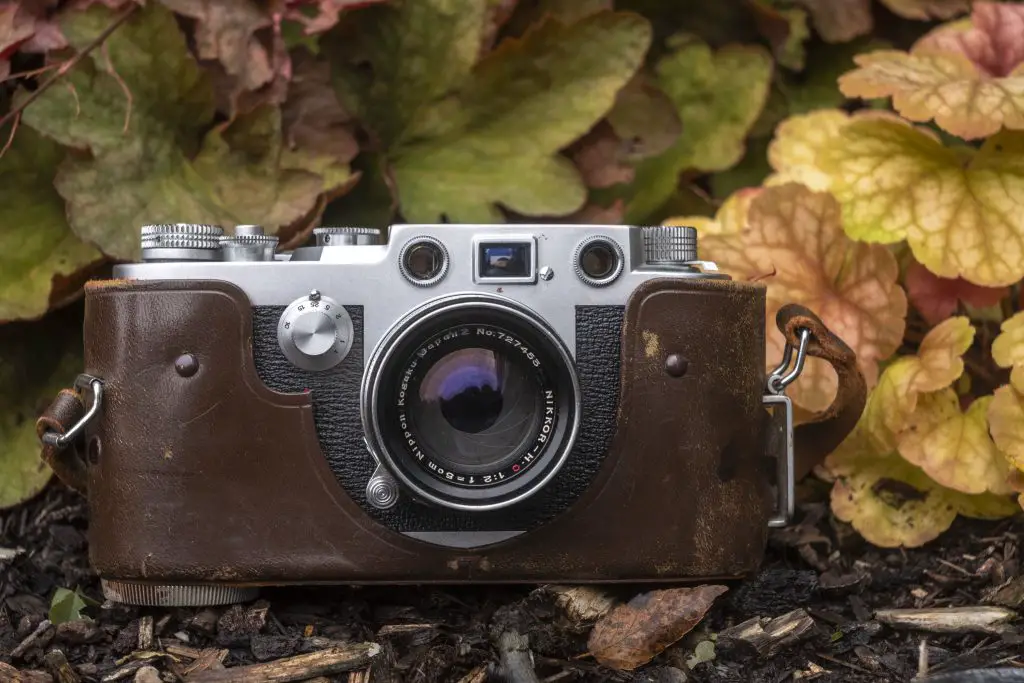 Film Type: 135 (35mm)
Film Type: 135 (35mm)
Lens: 5cm f/2 Nippon Kogaku Nikkor-HC coated 6-elements
Lens Mount: M39 Screw (Leica Thread Mount)
Focus: 1.5 feet to Infinity (3.3 feet to Infinity rangefinder coupled)
Viewfinder: Separate Viewfinder and Coincident Image Coupled Rangefinder
Shutter: Cloth Focal Plane
Speeds: T, B, 1 – 1/1000 seconds
Exposure Meter: None
Battery: None
Flash Mount: Coldshoe with FP and X Flash Sync (at 1/25 only)
Weight: 727 grams (w/ lens), 508 (body only)
Manual: https://www.cameramanuals.org/sears/sears_tower_35-45_nicca.pdf
How these ratings work |
The Tower 45 has the distinction of being one of the most unique takes on the original Leica II and one of the last. With features such as a film advance lever, Leica M3 style rear film door, a redesigned shutter release, and a rewind release button, the Tower 45 has features not available on M39 cameras. It was built to a very high quality standard by Nicca and came only with Nikkor HC lenses making them quite capable cameras. In use, none of the upgrades significantly improve the shooting experience from a real Leica, but they also don’t get in the way either. This is a very interesting and fun camera to shoot and own and one that I recommend anyone who collects or shoots Leica Thread Mount cameras to check out. | ||||||
| Images | Handling | Features | Viewfinder | Feel & Beauty | History | Age | |
| 2 | 2 | 2 | 1 | 2 | 1 | 30% | |
| Bonus | none | ||||||
| Final Score | 13.0 | ||||||
History
The early days of Japan’s camera industry came out of a necessity of the Japanese empire to stop relying on imported goods from other countries. In 1916, three small Japanese companies, Iwaki Glass Seizo-sho, Tokyo Keiki Seisaku-sho, and Fuji Lens Seizo-sho, were ordered by the Japanese military to design a new periscope for a new Mitsubishi submarine. Rather than work separately, on July 25, 1917, the three companies agreed to merge into a singular Japanese national optics company known as Nippon Kogaku Kogyo Kabushiki Kaisha, or Japan Optical Industries Co., Ltd. in English. This new company’s primary goal was to put an end, once and for all, on Japan’s reliance on imported lenses and rangefinders. The founding of Nippon Kogaku in 1917 came at the perfect time, as World War I was in full swing in Europe, and Japan had lost it’s ability to get imported goods from Europe.
After the merger, the three factories that comprised of the three original companies, continued to operate making specialized equipment for the Japanese Imperial Navy, the Japanese Army, and other scientific and industrial companies. Nippon Kogaku had over 200 employees, many of whom had years of experience in producing lenses, microscopes, rangefinders, and other optical apparatuses.
In the 1920s, Nippon Kogaku would quickly grow in size and by luring German optical engineers who were out of work after the collapse of Germany’s postwar economy, their capabilities at designing all kinds of military use scopes, rangefinders, and other optical goods grew. Despite this tremendous growth, Nippon Kogaku’s products were exclusive to the Japanese military and weren’t sold to the public. Japanese civilians, along with the rest of the world were largely unaware of anything Nippon Kogaku was producing.
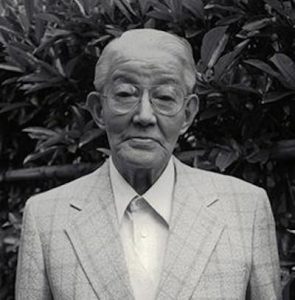
The loss of imported cameras and lenses from Germany had an effect on Japanese photographers and demand quickly increased for a domestic camera that could be built and sold to those who needed them. To meet this demand, in 1933, a modest repair technician named Goro Yoshida, Yoshida’s brother-in-law Saburo Uchida, and a third man named Takeo Maeda founded Seiki Kogaku, or Precision Optics Company in English, with the goal of building Japan’s first compact 35mm camera.
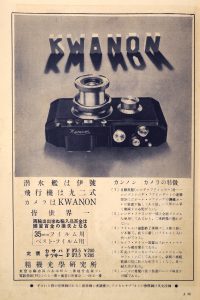
This new camera would be called the Kwanon, named after the Buddhist deity of mercy, and was shown in wooden and illustration form in various Japanese publications at the time, but according to Canon Global’s company history page, none were known to actually have been built. Goro Yoshida had at one time claimed to have built 10 Kwanon models, but this information has been doubted as none have ever been seen. There is at least one camera called a Kwanon Model D that is often cited as a real Kwanon, but it was later found to be a rebadged Leica II that was modified later. Most online sources with information about the Kwanon camera, show this fake Kwanon Model D.
Although Seiki Kogaku had the necessary technology and expertise to design the body and shutter to German specifications, they lacked the expertise in optics design, something Nippon Kogaku was great at. As a result, the two companies worked together to release the first Japanese built 35mm rangefinder, Seiki Kogaku would build the body and shutter, and Nippon Kogaku the lenses, rangefinder, and lens mount.
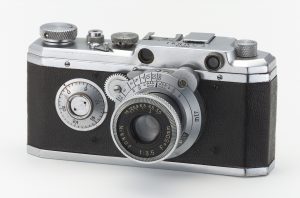
By the time it was ready for civilian consumption in 1936, Seiki Kogaku’s new camera had been completely redesigned and renamed the Hansa (or Standard) Canon as the name Kwanon had received some opposition as it was seen provincial and overtly religious. The Hansa Canon was very different from the original wooden Kwanon models, featuring a pop up viewfinder, a new lens mount, and support for Kodak’s type 135 film cassette.
The Hansa Canon would be built from October 1935 to about June 1940 at which time Seiki Kogaku’s production would shift to military use as Japan was now engaged in a war with China. During the time of the Hansa Canon’s production, a Japanese optical engineer named Kumagai Genji joined Seiki Kogaku to help work on the various iterations of the Hansa.
In 1940, Kumagai would leave Seiki Kogaku to focus on cameras rather than military products, but the circumstances in which this happened are unclear. Some sources suggest that Kumagai simply left the company voluntarily to start a new company called Kōgaku Seiki-sha, meaning Optical Precision Company to focus on a new Japanese Leica II copy, others suggest that a company called Ōmiya Shashin-yōhin K.K. who distributed the Hansa, ordered Kumagai and seven other Seiki Kogaku employees to setup a Canon repair shop for the Hansa and Canon S and J models that were in production. The similarity between the names Kogaku Seiki-sha and Seiki Kogaku was likely intentional, which leads me to believe the Canon repair shop version is the correct one as the new name was likely chosen so that people would associate them with Canon products. Whichever of these is true isn’t all that important as both agree that by 1940, Kumagai Genji was no longer affiliated with Seiki Kogaku.
The Hansa and new Canon models sold modestly to the public and although were positively received, production was slow and each had a lens mount that was difficult to make and incompatible with anything coming from Germany.
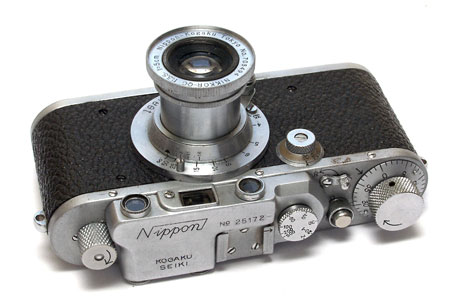
In 1941, Kōgaku Seiki-sha would be ordered by the Japanese military to produce an exact copy of the Leica III that could be built quickly and would use Leica screw mount lenses. In less than a year, a new patriotically named Nippon camera was created. The Nippon was nearly identical to the Leica III with one exception being that the rangefinder magnification was 1x instead of the Leica’s 1.5x. Otherwise, it was fully compatible with all Leica screw mount lenses. A later variant of the Nippon was produced without a rangefinder or slow speeds as well, but it’s even rarer than the first version.
Information about the Nippon camera is scarce and it’s name is confusingly similar to that of Nippon Kogaku, despite being produced by a different company. I am unsure if the Nippon was produced exclusively for military use, or if they were ever sold to the public. All sources that I’ve found suggest that very few Nippon cameras were ever produced, possibly less than 1000 total, and if they were used by the Japanese military, it’s likely many were destroyed during the war.
In 1948, Kōgaku Seiki-sha would change it’s name to Nippon Camera Works which they would use for only one year, changing it’s name once again in 1949 to Nicca Camera Works. The name “Nicca” likely came as a combination of “Nippon” and “camera”, similar to how Leica is a combination of “Leitz” and “camera”.
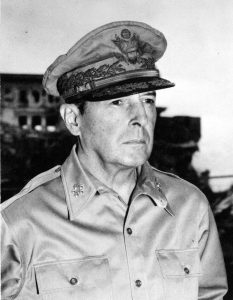
In the years after World War II, Japan’s economy was in shambles and resources were very hard to come by. By orders of General Douglas MacArthur, all Japanese industry had to be approved by the American Occupied Forces before anything could be made. The United States had an interest in rebuilding Japan’s economy and in order to do that, they needed an infusion of money, so products that were deemed easy to sell were approved with regularity.
The Nicca, being nearly identical to a real Leica was seen as an easy thing to sell, so in 1948 Nippon Camera Works would begin production of civilian Nicca cameras. Although Nippon Kogaku had gained favor by American forces and photographers for their lenses, they weren’t yet known for their cameras leaving only Nicca and Canon as two of the only Japanese camera makers exporting their products out of Japan. The Nikon rangefinder wouldn’t start to gain significant recognition until the release of the Nikon S2 in 1955.
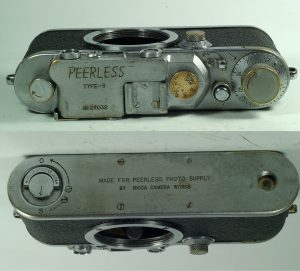
In 1949, Nicca would produce their first camera to gain some popularity. The Nicca Type 3 was a more refined version of the original Nicca camera. The Type 3 was sold branded both with the Nicca name, but also with the name of some of it’s distributors. One such example was for cameras sold by Peerless Camera in New York City. These “Peerless Niccas” are extremely rare but did exist.
In 1951, the Nicca Type 3 would be renamed the Nicca IIIA, and a new version with flash synchronization called the Nicca IIIB was released. These two new cameras were important as also in 1951, Nicca struck a deal with the Sears, Roebuck, & Company, a very large American department store retailer. Under this new deal, Nicca would produce cameras for Sears under their own house brand, Tower. The first Nicca sold under this deal was the Tower 35 Type III.

In the ad from the 1952 Sears Camera Catalog, the Tower 35 Type III sold with a case and Nikkor f/2 and f/1.4 lenses for $175 and $298 respectively. When adjusted for inflation, these compare to $1700 and $2900 today. Although steep in price, in a January 1952 ad for Peerless Camera in New York City, a brand new Leica IIIC with f/2 Summitar had a list price of $350, nearly twice that of the Tower.
With the release of the Tower 35 Type III, Sears would become Nicca’s primary distributor in the United States. This partnership would continue until the end of the decade when Nicca would be absorbed into Yashima and stop producing cameras under their own name.
As each new Nicca model was released, an equivalent Tower version would as well. For the most part, the changes to each new Nicca model were incremental with the most significant upgrades being flash synchronization, a change to the film reminder dial on the advance knob, and in the Type-4, the addition of a top 1/1000 shutter speed.
In 1955, Nicca would make it’s first of a couple significant changes to the original Leica III design it was ordered to copy in 1941 with the release of the Nicca Type-5. The first was a Leica M3 style hinged door on the back of the camera which would allow the photographer to see both the film plane and the film as he or she loaded it into the camera. In 1957, an updated Model 3-F would add a film advance lever, relocated shutter release button, and rewind push button, and in 1958, the III L a combined coincident image rangefinder.
Sometime during the middle of 1957, Sears would begin selling a new camera which would later be revealed to be the Tower 45 and 46 which had the same hinged rear door of the Type-5 and the film advance lever, relocated shutter release, and rewind push button of the updated 3F. At the time of the new Tower’s release, there was no Japanese market Nicca branded equivalent with a film advance lever, M3 style door, relocated shutter release and rewind button, and a top 1/1000 shutter speed.
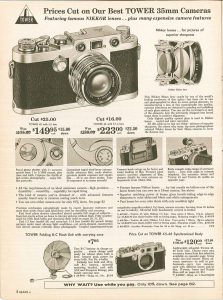
The Tower 45 and 46 were identical with the only difference being the lens that came bundled with the camera. With the 45 came a Nikkor f/2 and with the 46 came a Nikkor f/1.4 for $189 and $269 respectively.
The page to the right from the 1959 Sears camera catalog shows an original price of $175 which matches the price of the original Type III from 1952, but now has a reduced price of $149.50 which when adjusted for inflation, comes out to $1325 making it quite a bit cheaper than the earlier Tower.
By the late 1950s, despite having a seemingly strong relationship with Sears, Nicca ran into financial trouble. Their Nicca rangefinders were the only products the company made, and with a dwindling demand for screw mount 35mm rangefinders, their sales slowed to a crawl.
At first, when Nicca started to struggle, no one was interested in them as the Japanese optical market was flooded with camera companies. But then another struggling Japanese company, Yashima Optical Ind. Co., Ltd. stepped in.
Yashima’s founder, Yoshimasa Ushiyama, had realized that Single Lens Reflex cameras were increasing in demand and that Yashima would need to produce their own SLR if they were to stay competitive. By this time, Asahi Pentax and Miranda already had their own SLRs with models from Minolta, Nikon, and Canon coming soon. Without much experience in making 35mm cameras and no experience with focal plane shutters, Yashima sensed an opportunity to acquire a company that already had this experience and in May 1958 bought Nicca before they filed for bankruptcy, which meant they acquired all of their technology and knowledge at a bargain price.
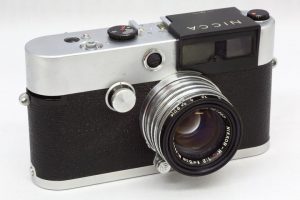
The last Nicca branded camera would be released in early 1958 as the Nicca III L. Featuring Nicca’s first ever combined coincident image rangefinder, an entirely new top plate, a redesigned film advance lever, and the same Leica M style door on the back plate, the III L was the last new camera prior to Yashima’s acquisition.
Two more Nicca cameras with the Yashica name on them were released later in 1958 as the Yashica YE and dual branded Nicca/Yashica YF, but these were just rebadges of the Nicca 33 and III L respectively. When both of these models ceased production in 1960, the era of Nicca as a camera maker was over.
Today, there is a demand for pretty much every screw mount Leica copy regardless of who or where it was made. Although much smaller than Canon who was Japan’s leading maker of Leica Thread Mount rangefinders, Nicca cameras enjoy a pretty positive reputation with collectors today. Unlike Canon who almost immediately strayed from the original Leica III formula, Nicca stayed true to the original design until at least the mid 1950s. Having only a single camera line to produce, their quality control was pretty good, and their partnership with Nippon Kogaku meant that most Niccas were purchased with top of the line Nikkor lenses.
Although less common than Canon rangefinders of the day, when found in working condition, Nicca and Tower branded rangefinders are often much cheaper than original Leicas and in use are just as good (flame suit on) making them an excellent addition for any collector looking to get into Leica cameras without having to pay Leica prices.
Nicca 5L / Tower Confusion
In an early draft of this article, I started out by saying that the Tower 45 was the Sears version of the Nicca 5L, just like pretty much every other Internet site claims. And while there is some truth to this, it’s not as simple as to say Nicca made Tower 45s and 46s for sale by Sears and 5Ls for sale elsewhere.
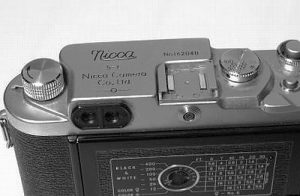
The reason for this is that in all of the Nicca collections in the world and all the research done by people on the Nicca 5L, only one example is known to exist. One.
The image to the left can be found on Massimo Bertacchi’s corsopolaris.net site which appears to be the only example of this camera found anywhere online. No one knows where this camera is today, or in whose collection, or whether it’s even real or a modified version of a different camera.
Another item that the Internet doesn’t seem to agree on is when the Tower 45 and 46 cameras first went on sale. I’ve seen references suggesting as early as 1955 and 1956 and some that say 1957. A combination of extensive research done by Paul Sokk and the fact that the Tower 45 and 46 didn’t appear in Sears catalogs prior to 1957, gives pretty good evidence that 1957 was the year.
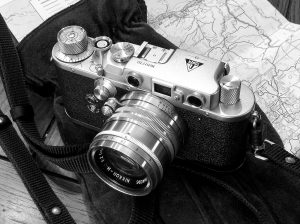
Further complicating matters today is that the names “Tower 45 and 46” aren’t printed anywhere on the camera and weren’t consistently mentioned in catalogs or marketing materials. As recently as the 1958 Sears Camera Catalog, both models were simply referred to as the Tower 35, a name which was used for many previous models as well. The 1959 catalog is the only one in which the numbers 45 and 46 are mentioned. On earlier models like the Tower Type III, the camera was marketed as the “Tower 35mm Type III”, somewhat matching the original Nicca name the camera was sold in Japan. There even exist Tower 42 and 43 models which were likely the Nicca 3S or Nicca 4.
Since the difference between a Tower 45 and 46 is only in the lens that came with it and we know that by the mid 1950s, Sears stopped making an effort to label their cameras with a model number similar to what Nicca was using, we can say that the suffix numbers were primarily used as catalog numbers.
Finally, there is information out there that say the Nicca 5L and Tower 45/46 were the first Leica III copies that had a Leica M3 style door and lever wind. This is incorrect as the Nicca Type 5 from 1955 was the first with the door, and the second variant of the Type 3F from 1957 was the first with a lever.
“Second Variant of the 3F”, you say? What’s that?
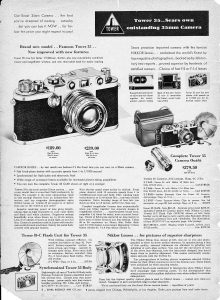
Further adding to the notion that Nicca didn’t consider 21st century internet bloggers when naming their cameras, between 1956 and 1958, there were three distinct variants of the Nicca 3F. The first went on sale around October 1956 and was a replacement for the earlier Nicca 3S, featuring a redesigned top plate, relocating the flash connector from the front to the back, adding a lock on the front slow speed dial, and a new film reminder dial on top of the winding knob. Both the 3F and 3S were knob wind cameras with a top 1/500 shutter speed.
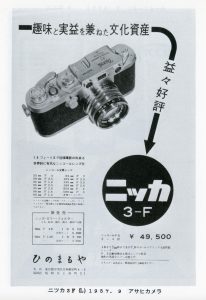
The knob wind 3F was sold by Sears as a Tower model and can be seen as the primary image in their 1957 catalog to the left as the Tower 45 likely wasn’t available when the catalog was being printed. You can clearly see the knob wind, lack of diopter adjustment around the rewind knob, and if you look closely at the shutter speed dial, the top speed is 1/500, despite the ad selling the features of the Tower 45 with it’s hinged back and top 1/1000 shutter speed.
The second variant of the 3F started to appear in Japanese advertisements around July 1957 and featured the same film advance lever of the Tower 45 and 46. The camera was otherwise identical to the earlier 3F, including the top 1/500 shutter speed. Sears sold a version of this camera as the Tower 48.
The third and final variant of the 3F is the rarest, with a known serial number range suggesting less than 300 were made. It has an identical feature set to the Tower 45 and 46 and mythical “Nicca 5L” including it’s top 1/1000 shutter speed. This camera first went on sale in late 1957, possibly in early 1958 and has a six-digit serial number that’s in the 16xxxx range.
No one knows why Nicca made three different cameras all with the same name. The Nicca 3Fs were all sold in Japan and sold modestly well, but by the time they were sold, Nicca was already having significant financial troubles. It’s possible that rather than come up with a new name, they just kept selling the same model, incrementally updating it’s features to help get them out faster. This is pure speculation, however.
So what about the Nicca 5L? When did that come out?
Aside from the one single Nicca 5L shown above from Massimo Bertacchi’s site, it would seem that this camera was never intended to be put into production. The one example found has a serial number of 162040 which puts it within the last known 3rd variant of the Nicca 3F with identical features.
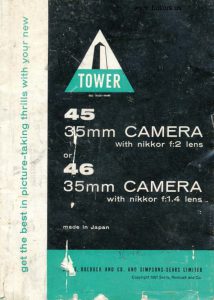
There also exists a manual for a camera called the Tower 35 Model 5-L which possibly suggests that “Model 5-L” was either an internal name for the camera or possibly an alternative name considered, but later discontinued in favor of “Model 45 and 46”.
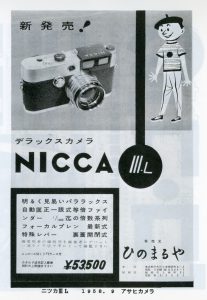
If the serial number of the one and only Nicca 5L means it was produced near the end of the third variant of the Nicca 3F, this means it was made around the same time as the new Nicca III L which had a completely redesigned top plate with restyled film advance lever and slow speed knob, and a much larger and combined coincident image rangefinder.
The Nicca III L would have been seen as a definite upgrade to the 3F or even the 5L and coinciding with the May 1958 purchase of Nicca by Yashica suggests there likely wouldn’t have ever been a reason to market a Nicca 5L in Japan or any other market. Perhaps the 5L was going to be a way for Nicca to sell off some remaining inventory at a reduced price parallel to the Nicca III L, but that’s another wild guess of mine.
The absence of a mass produced Nicca 5L is why you’ll never see a picture of one in any McKeown’s guide, Sugiyama’s “Collector’s Guide to Japanese Cameras”, or Pont & Princelle’s “300 Leica Copies”. In the September 1978 issue of the Japanese language “Camera Collector’s News”, author Mikio Awano plainly states that the 5L was never put into production possibly even suggesting that serial number 162040 might even be a forgery.
A bulk of the information in this section came as a result of a conversation I’ve had with Paul Sokk whom I previously interviewed in my One Hour Photo series. Paul is an extremely organized and thorough historian who has a fascination with Yashica TLRs and Nicca rangefinders that is unmatched in the collector’s community.
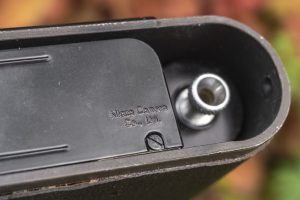
Paul suggests that a lot of the incorrect information on the Internet today regarding these cameras comes from earlier research done by other historians who didn’t have access to the same information that we have today. Other websites recite this same incorrect information and it eventually becomes “common knowledge”.
With the research Paul has done, we now know that although one Nicca 5L did physically exist, and there was internal documentation referring to the Tower 45 and 46 as a Model 5L, that it is not correct to say that the Tower 45 is just the Sears version of the Nicca 5L. The one and only example of a 5L we know of was likely built after, or near the very end of Tower 45 and 46 production. A more accurate statement would be that the third variant of the Nicca 3F was the Japanese equivalent, as it has been the only Nicca branded camera seen in circulation with the same specifications as the Tower cameras.
My Thoughts
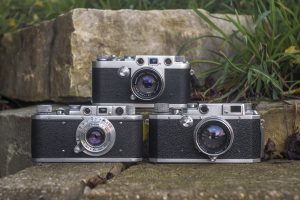
In a review of the Canon IVSb on his blog, self-described Leica fanboy Johnny Martyr acknowledges the need for companies like Canon, Nicca, and a host of others to improve upon the original Leica II and III. Features like a larger viewfinder, a hinged back, and a film advance lever certainly make the cameras more accessible to those not used to the original Leica, but they also weren’t totally necessary. Johnny affectionately refers to these features as “Barnack Training Wheels”.
Although Johnny never reviewed the Tower 45, I think he’d likely make some of the same comments as he did about the Canon. And you know what, he’s not wrong. None of these features are requirements to shoot good pictures on the real thing as thousands of photographers did it for decades. Loading film into a bottom loading camera isn’t that hard. For your first time, yes, the door does help you see the film line up, but once you’ve done it a couple of times, you don’t need the door. Yes, the film advance lever gives the camera a slightly more modern feel to it, but I question how many photographs actually benefit from a lever over a knob.
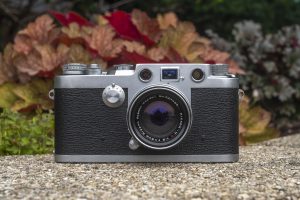
Still, there are those who might find the “upgrades” to the Tower a reason to seek one out, so when one came up for sale from fellow collector Bob Houlihan, I arranged a deal that we were both happy with and now I have one in my collection.
At a quick glance, the Tower 45 looks close enough to a Leica IIIf that someone not familiar with either camera might assume this is the real thing. Up front, the two cameras share nearly identical body dimensions, a similar looking front mounted slow speed dial, the same lens mount, and a stepped top plate that has many of the same contours. Unlike Leica copies made in the Soviet Union, there are no differences in the trim around the three windows, the body coverings are the same, and the position of the lens is the same at infinity. On a scale, the Tower is noticeably heavier at 508 grams (body only) than the Leica IIIf at 429 grams which suggests more parts and possibly less weight saving measures than Leitz may have taken.
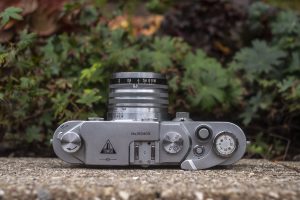
Up top, it quickly becomes apparent that this is not a Wetzlar design. For starters, the triangular Tower icon is the first giveaway. Unlike Soviet Leica copies which are cheap and plentiful, Nicca based Leica copies are rare and valuable enough that few (if any) were ever engraved with a fake Leica logo.
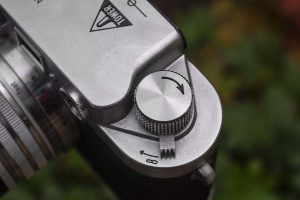
The left rewind knob has a diopter adjustment beneath it, which allows for precise control over the left rangefinder window. This is useful for people with eyeglasses or less than perfect vision. In the center is the accessory shoe, next to the single piece shutter speed dial. Like any Leica III, only speeds from 1/25 through 1/1000 plus Bulb are indicated here. The dial rotates both when cocking the shutter and while firing so you must take care not to touch this dial while releasing the shutter as it will throw off your exposures. Since the position of this dial changes before and after the shutter is cocked, there is a black dot to indicate the selected speed with the shutter cocked, and a red dot that indicates the speed with it uncocked.

Moving on, the Tower 45 relocates the shutter release button closer to the front of the camera in a position where your index finger will more naturally locate it. Instead of an A/R switch, there is a rewind button that works the same as these buttons do on other cameras.
Finally, we have the rapid advance lever, which for someone seeing this camera for the first time looks very out of place. On my example, this lever is quite firm, but it’s length and function is like any other. Finally, there is a manually resetting exposure counter above it.
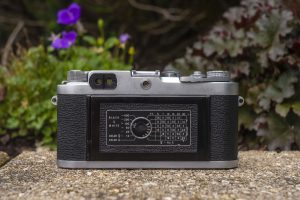
Moving on to the second most significant feature of the Tower 45 is another “Leica training wheel”, which is the hinged door on the back of the camera. Loading film into the Tower 45 is still through the bottom like the Leica M3, but with this door in the up position, it is no longer a requirement to trim the leader since you can help guide the film over the sprocket wheels without jamming or tearing the film. The reality is, this doesn’t save as much time as you might think as cutting the leader is something that can be done with a pair of scissors in less than 5 seconds. The loading process still requires you to remove the bottom plate and both spools, attach the leader to the take up spool outside of the camera, and then drop both spools into the camera at the same time, taking care to line the film up with the film plane correctly, without catching on anything.
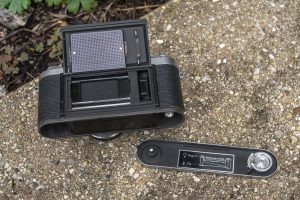
It probably wasn’t at the top of Nicca’s marketing department when developing this feature, but my favorite use for the door is to inspect the shutter. If you’ve ever picked up a bottom loading camera before and wanted to confirm if the shutter was light tight, you needed to shoot film through it to see if there are any pinholes, but now, you can inspect the curtains by simply pointing it at a light source and looking through it. This might also be useful for confirming focus by installing a ground glass in the film gate if you had a reason to do so.

The bottom of the camera has the usual lock which not only functions as the release for the bottom plate, but when using metal reloadable cassettes, opens and closes the cassettes for removal. Opposite of the lock is a standard 1/4″ tripod socket. Since the entire bottom of the camera is removable, this socket is built into the plate itself which isn’t as strong as when it’s built into the body itself. This causes issues when the camera is mounted to a tripod and bumped as the stress can bend the metal.

Up front, the Tower 45 features the same M39 screw mount as countless other Leica copies. Unlike Soviet FEDs and Zorkis however, there is absolutely no difference in the lens mount ensuring 100% compatibility with all other Japanese or German Leica Thread Mount lenses.
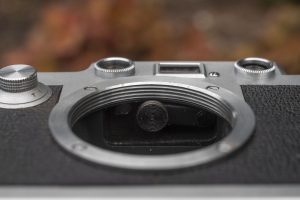
The rangefinder coupling is a wheel instead of a lever like that used on Soviet copies, ensuring a smooth and accurate motion of the rangefinder when changing focus. With the lens focused to infinity, the focus knob locks in place, near the 7 o’clock position around the lens.
All Nicca and Tower cameras sold since 1948 came with Nippon Kogaku Nikkor lenses, and the Tower 45 is no exception. The Nikkor HC 5cm f/2 is optically identical to the same lens in Nikon rangefinder mount. It is a 6-element lens with a hard lens coating that retains it’s original purplish blue color as when it was first made.
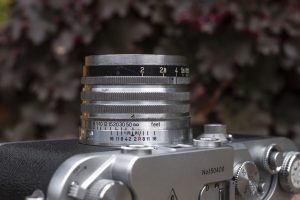
The lens is made of solid brass and despite it’s compact size, is quite heavy. The front aperture ring has click stops at every position between f/2 and f/16, and the focusing lever is smooth from infinity, all the way down to it’s minimum focus at 1.5 feet. You’ll notice that the focus distances from infinity to 3.5 are engraved in black and the numbers less than that are in red. This is to indicate that the lens can focus closer than the rangefinder’s 3 foot minimum. When moving the focus arm from 3.5 feet down to 3 feet, you’ll feel a slight amount of resistance at the exact moment the rangefinder cam becomes disengaged. This is perfectly normal and a way to let the photographer know that the rangefinder is no longer coupled to the lens for close ups.
One area in which Nicca did not stray too far from the original formula is in the separate coincident image rangefinder and viewfinder windows. The majority of rangefinder cameras introduced in the 1950s and on had a combined coincident image rangefinder in which the rangefinder patch was superimposed in the center of the main viewfinder window. When the first Leica II was introduced in 1932, it’s rangefinder window was kept separate from the main viewfinder window. Many rangefinder cameras followed this same formula and to someone who has only used a combined rangefinder, might see this as an archaic step backwards.
I am guilty of this thinking as well, that being able to focus my image while composing the shot all in the same window without ever having to move my eye was a superior way to do it and while yes, it is faster, but there are perfectly good reasons to prefer a separate setup like the original Leica and this Tower 45 had.
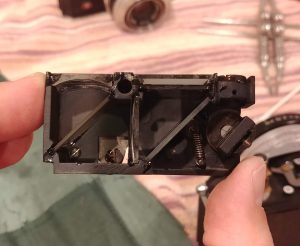
It comes down to something called Effective Base Length (EBL), which is a simple multiplication of the physical distance between the two rangefinder windows by the magnification of the rangefinder window. Since a rangefinder uses two images from two separate windows converging on a single point to accurately measure distance, the farther apart those two windows are, the more precise it can be. Move the windows closer together, and it becomes more difficult to see a difference between the two. If you have a rangefinder with a short physical distance, you can compensate by magnifying the image to increase EBL. So, for example, a rangefinder whose windows are 60mm apart and has a 1x viewfinder, has a 60mm EBL, but another rangefinder with windows 40mm apart and a 1.5x viewfinder has the same 60mm EBL.
With a wide angle or medium speed 50mm lens mounted to the camera, a short EBL isn’t that big of a deal, but mount a fast 50mm lens or a telephoto lens which require critical focus, and a short effective base length becomes a problem.
The problem with combined coincident image rangefinders is that in order for the image from the rangefinder and the main viewfinder to line up, both have to have the same viewfinder magnification. Almost every rangefinder camera has a viewfinder that is less than 1x, because it allows you to see more of the image in the viewfinder window, so when you combine a rangefinder window into a viewfinder with a sub 1x magnification, you are actually decreasing EBL. Manufacturers can compensate this loss in EBL but putting the two rangefinder windows farther apart, but this adds complexity and cost to the design.

With cameras like the Tower 45 that keep the rangefinder and viewfinders separate, the rangefinder can have a different magnification than the main viewfinder, increasing it’s EBL. The Tower 45 shares the same 39mm x 1.5 magnification for a 58.5mm EBL as the Leica II and III which compares favorably to the Leica M3 which many people consider to have the most accurate rangefinder for fast and telephoto lenses with a 62.3mm EBL.
So while yes, the dual window design of the Tower 45 and other similar cameras is a tad bit slower in that you have to move your eye between different windows, but the pay off is a much more accurate rangefinder since it is magnified differently than the main viewfinder.
The viewfinder arrangement in the Tower 45 is excellent. In the composite image above, I show both the rangefinder and viewfinder pointed at the same utility pole. Another minor benefit to keeping the windows separate like this is that in order for a coincident image rangefinder to work, it needs something called a beamsplitter which reflects a portion of the light passing through it to the second window, somewhat dimming it. Since the rangefinder is separate from the viewfinder, there is no beamsplitter the main viewfinder window, improving it’s brightness.
My Results
After receiving the Tower 45 and seeing that everything seemed to be in perfect working order, I couldn’t wait to load in some film and take it out shooting. For my first roll, I used a fresh roll of Kodak ColorPlus 200 on a trip to Michigan. I brought the camera with me to the Founders Brewing Company’s brewpub in Grand Rapids, Michigan, and while this isn’t a beer review site, I will say that this place is amazing.
Living in Indiana which borders Michigan, I was already familiar with many of Founders more common beers, but when I got there and saw how many taproom exclusives they had, I was blown away. The place is large, with lots of indoor and outdoor seating, two separate bars, and a really great menu. Whether you like craft beer or not, this is a place that I would recommend anyone who passes through Grand Rapids visits. As an added plus, it is right off the interstate, so it’s very easy to find and get back on the road.
This second gallery was shot in spring of 2020 on Kodak Vision 50D. This being a cinema film, there’s the issue of Remjet that must be removed before the film can be developed. It’s not hard to do as it only requires some baking soda and some rubbing, but if you’re willing to add that extra step to your development process, you’ll be rewarded with a very distinct look.
The “D” in 50D indicates that this film is color balanced for outdoor light. This gives outdoor shots a very natural and slightly warm tint to them. These shots were taken in and around Turkey Run State Park in Marshall Indiana, and both the camera and the film seemed to be a perfect match.
Nippon Kogaku first became one of the world’s most dominant optical powerhouses on the strength of their lenses. The later Nikon F cemented their place in history, but it was their lenses that got them a majority of recognition in the 1950s.
When dealing with a top tier lens maker, you expect the best, and it would take a catastrophic failure by whatever camera the lens was mounted on to get anything less than outstanding images, and I’m happy to report that the Tower didn’t mess anything up.
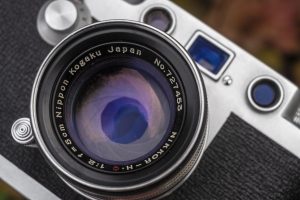
Each of the images from both rolls of film are sharp from corner to corner, show excellent contrast and detail, and lack any of the optical anomalies you might see on lesser lenses. Simply put, these images are just as good as anything you would get on a Nikon rangefinder or any other screw mount camera with a Nikkor lens attached.
The experience of shooting the Tower 45 was excellent as well. I was fortunate to get this camera in near perfect condition with an accurate shutter and bright and clear rangefinder and viewfinder windows. I had no difficulties obtaining focus on any of the images, and using Sunny 16, each of the images look properly exposed.
The big question about the Tower 45 is whether it’s changes are an upgrade to shooting an original Leica III or something similar like the Canon IVSb, and for that, I will go back to what Johnny Martyr said earlier in his review and say that each of the Tower 45’s improvements don’t improve the shooting experience of the Leica III. Sure, having a film advance lever is ever so slightly faster than a knob, and the rear door allows you to confirm the film leader is properly attached, but neither of these features will get you better images.
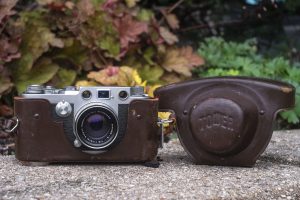
Although yes, a lever can shave off a few fractions of a second from that of a knob, if I really need to shoot a rapid sequence of shots, I am going to use something with a motor drive and not a screw mount rangefinder.
I do like the more up front location of the shutter release, but we’re talking about a difference of maybe half an inch. It’s not like they corrected some kind of egregious ergonomic failure.
I can say though that the build quality on this Tower is excellent. I have heard from many people who repair cameras like these who suggest that Nicca cameras are very close in build quality to the original, and based on my unscientific opinion, I feel as though no shortcuts were made with this camera. The Tower 45 feels like a precision instrument, and despite being over 53 years old, likely is in as good of operating condition as it was when it was new.
I can also credit Nicca by saying that although none of the upgrades improve the shooting experience, they also don’t detract from it either. There is nothing about this camera that is any less than shooting a Leica III. Johnny might disagree with me here, but he was impressed with the build quality and refinement of the Canon IVSb, and comparing this camera to that one, I’d say that the Tower compares favorably.

There are still many reasons to buy a Tower 45, Perhaps there is someone who has never shot a screw mount Leica before and is intimidated by a knob wind and not being able to see the film leader while loading. Maybe you just want to save money as even though the Tower 45 is a much less common camera, they can still be found for less than an equivalent Leica, so it might be a more economical way to start shooting Leica glass. Perhaps you just like screw mount cameras, or those that are different from all the rest.
Each of the above are worthwhile reasons to add a Tower 45 to your collection. They’re well built cameras that are easy to use, make excellent pictures, and are compatible with any screw mount lens. I have many reasons why I love this Tower 45, but none of them are that it’s a better camera than a Leica III. It’s just different.
Related Posts You Might Enjoy
External Links
http://camera-wiki.org/wiki/Nicca
https://www.cameraquest.com/nicca.htm
https://www.johanniels.com/en/camera-gear-blog-posts/rangefinders/105-tower-45-leica
http://corsopolaris.net/supercameras/nicca/nicca.html

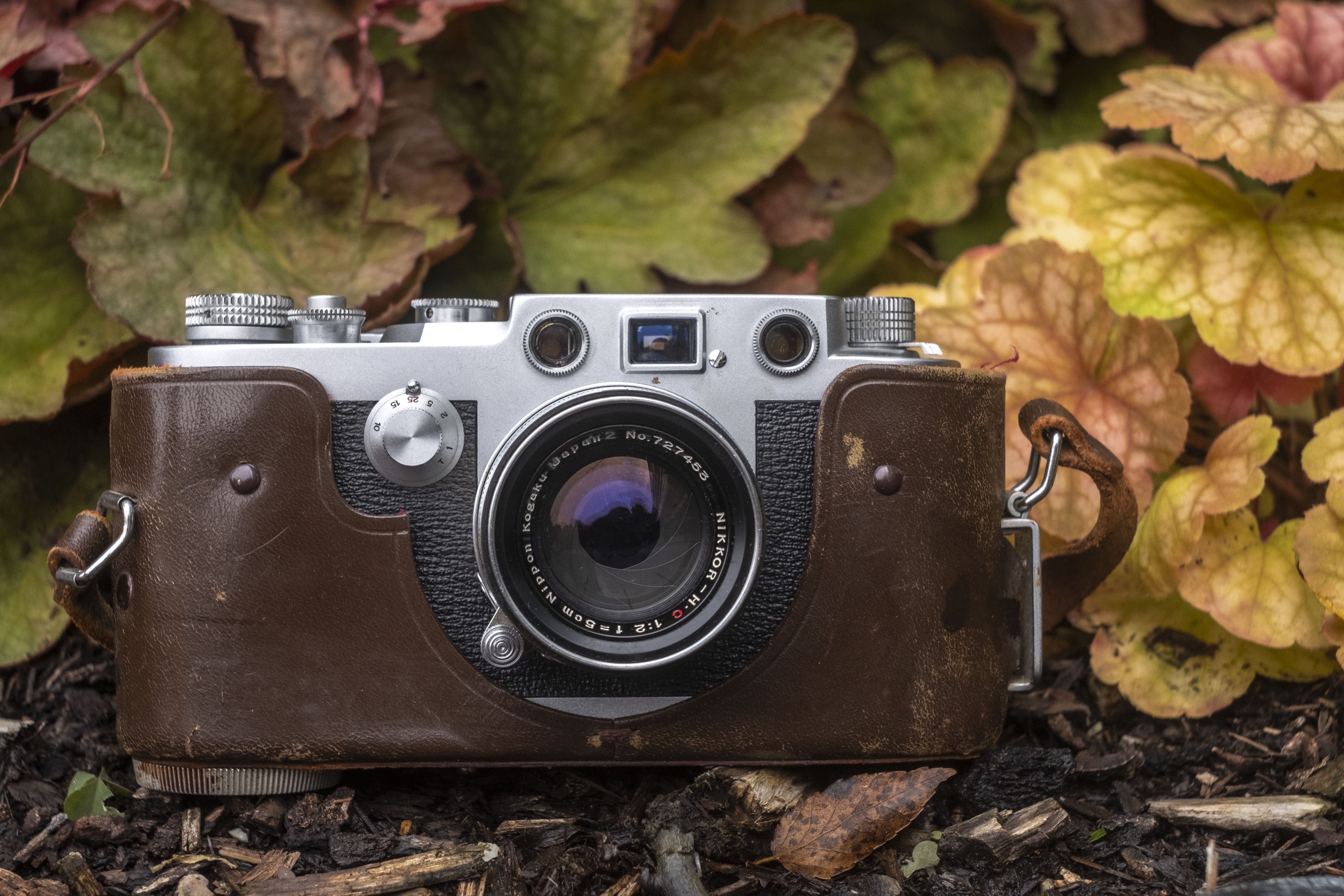

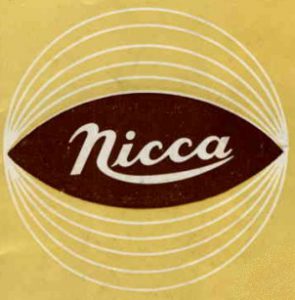
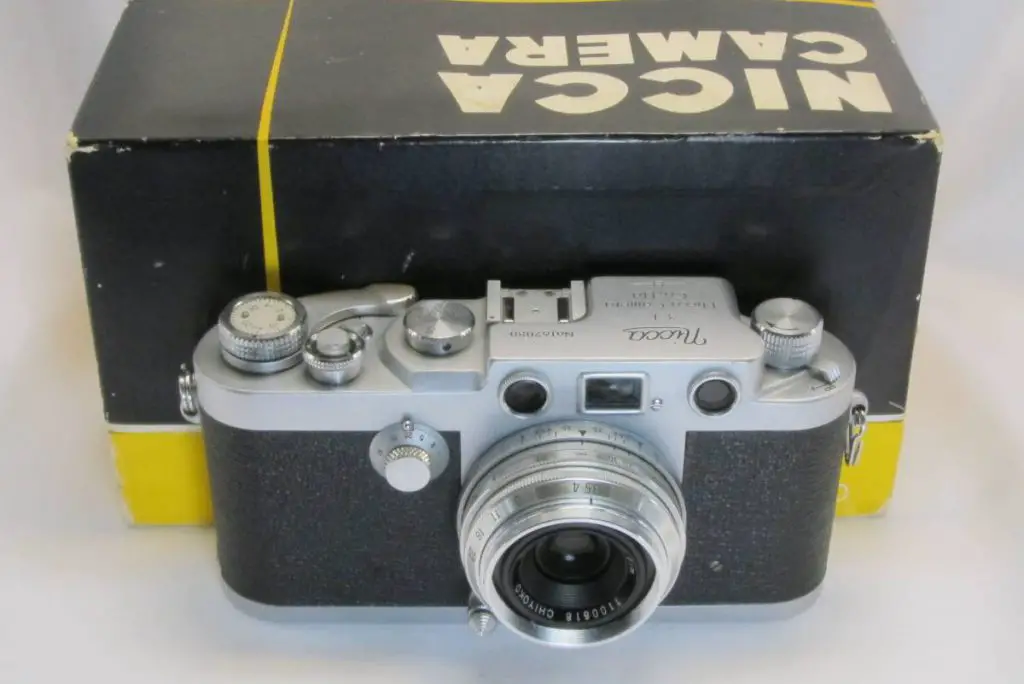
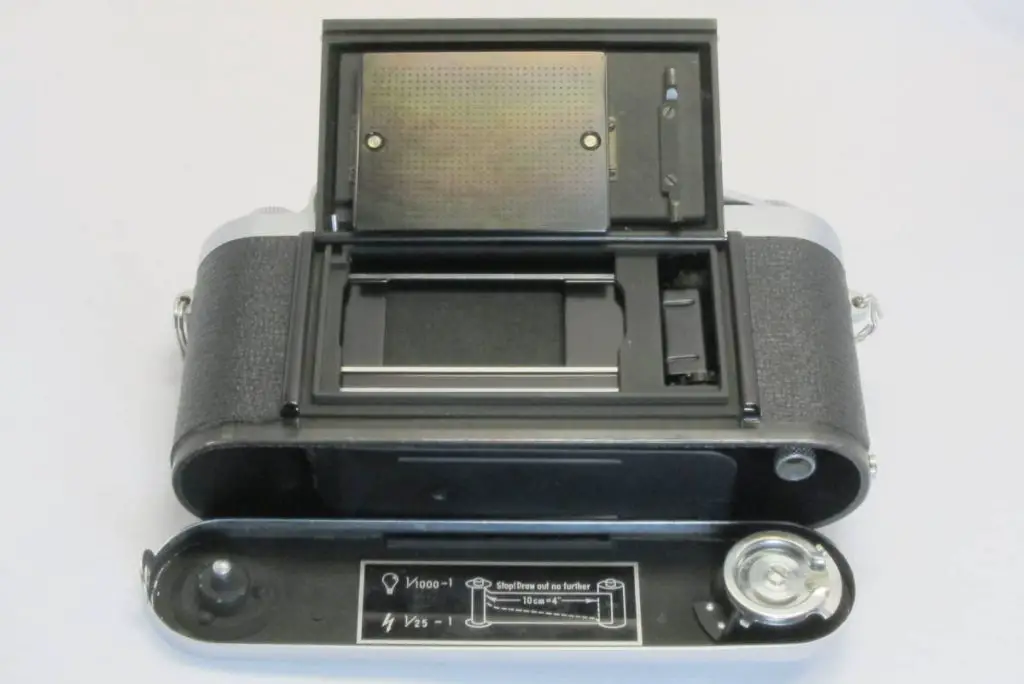
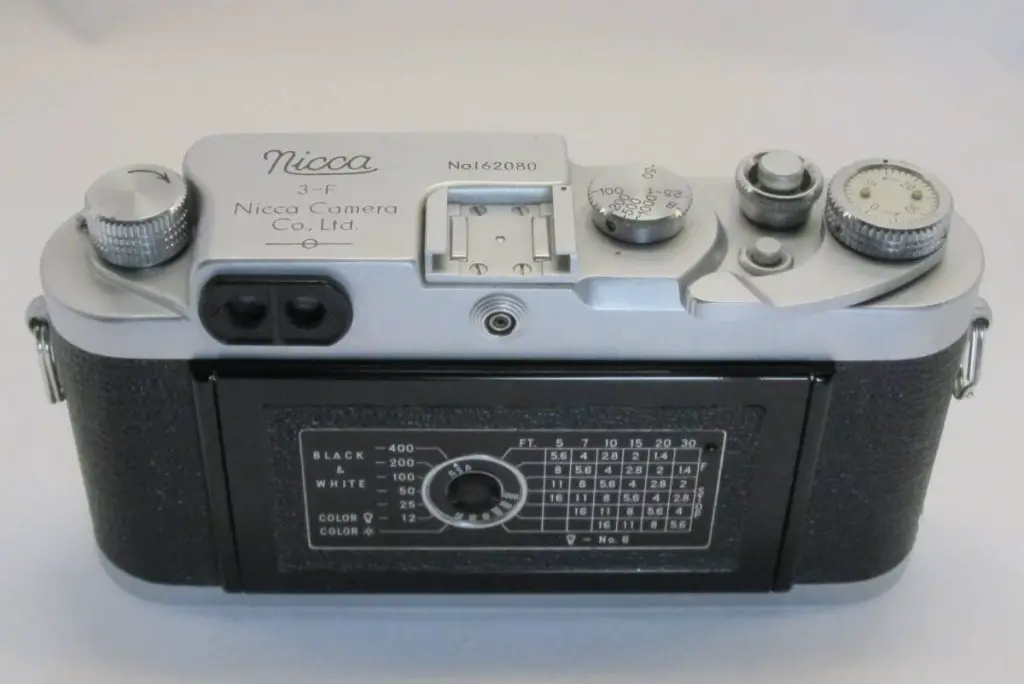























Mike,
Another great revue. Had a Tower 45 which I paid a lot of money for and used it a few times and concur, it was a joy to use and the Nikkor was as good as most say. I ended up getting more into the Leotax system and figured I didn’t need so much duplication with Nicca.
Sold it for a bit more than I paid (which was nice) but to me the two outstanding features were the 1/1000 sec top speed and the door loading.
Great camera and some day I may wish to have another!
Congrats on a fine, well researched article! It took me a few days to actually absorb the info… This post confirms the worth of your site to the readership in general and to collectors in particular. Keep up the good work, Mike. After all these well-written reviews, I hope to see a compendium of them in book form in the future! Just a thought…
Thanks for the compliment Bob! People have asked me before if I would ever consider writing a book and while there is some appeal in that for me, I am unsure if I’ll ever do it as if I were to publish anything, then I’d have to be REALLY sure I have all my facts right! Being able to stand behind a blog saying that it’s free, that I’m not charging anyone money for it, has it’s advantages too! 🙂
Excellent post… no, outstanding post! Congrats on your successful research. You’ve made us Nicca-Tower guys very happy.
Thanks for the feedback Chris! The amount of info you and Paul have contributed to Nicca and Yashica’s history is impressive and I am happy to in some small part be able to add to that.
For someone that has done a lot of research on Niccas, this was a very enjoyable read and I managed to both learn some new stuff and gain a new perspective on the relationship between Leicas and copies. An excellent article/review that I would recommend to anyone with an interest in the subject. Well done Mike!
Thanks for the kind words Paul! You were a great help with this article and what I’ve compiled here pales in comparison to the work you’ve done researching these. Sometimes in an effort to consolidate a massive amount of info into a shorter article like this, some things can get lost, and I am happy that didn’t happen too badly here! 🙂
Great article on a little-known camera. Sears was a great place to buy reasonably priced cameras. In 1958, for $90, I bought a Sawyer’s Mk IV (127 TLR) there’ I used it hard for years and still have it.
Film advance knobs are definitely slower than levers, and you have to lower the camera from your eye to work them; back then that mattered. My old favorite, the Canon VT, uses a trigger-like lever similar to a Leicavit.
As you know, I just bought a third variant, Type 3-F. I haven’t developed any of the photos I’ve taken with it yet, but I agree, there’s nothing about it that feels better than a Leica IIIf BD (for example). But it feels just as robust, and I like the door, as it allows me to feel the little sprocket tooth sticking through the film’s sprocket hole with my finger. Yeah, it comes down to that. The lever wind just reminds me of shooting with a Zorki 6 or 7, and does not make it feel “classier” to be winding the Nicca, compared to winding a Leica. I don’t like crank-winds on TLRs, either. The viewfinder and rangefinder seem super bright and clear, though. It’s not better than a Leica, it’s just different, as you’ve said.